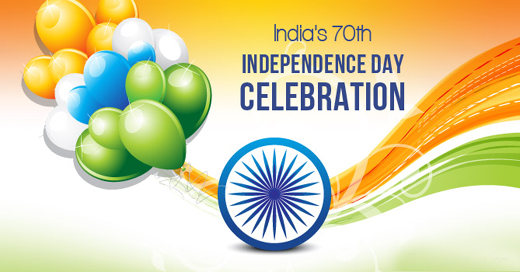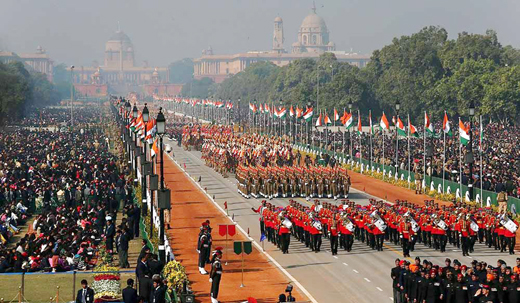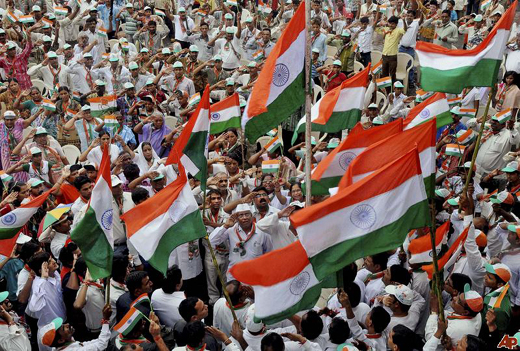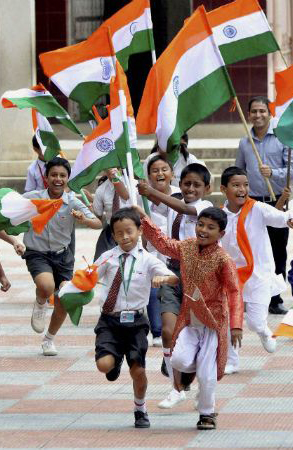India gets ready for 70th Independence Day celebrations
India gets ready for 70th Independence Day celebrations
Mangalore Today News Network
Mangaluru, August 13, 2016: On 15 August, India celebrates its 70th Independence Day. This year, Independence Day celebration is going to be different and special. In its Parliamentary Party meeting held on 19 July, PM Modi spoke to his party colleagues of his desire to make this year’s Independence Day celebration exceptional.
It has now been decided that for the first time, the celebration of India’s independence will involve a six-day long ‘Bharat Parv’ festival at Rajpath near India Gate in the national capital, beginning 12 August.

In addition to Bharat Parv, ‘Tiranga Yatras’ will be taken out across the country from 15-22 August. The purpose of both programs is to include other states in the celebration and ensure it’s a people’s festival that will invoke patriotism and pride for the nation.
Apart from that, to commemorate the nation’s 70th Independence Day, the government has outlined an additional detailed 15-day long program. It will be launched by Prime Minister Narendra Modi as ’70 Saal Azadi – Zara Yaad Karo Qurbani’ (70 years of Independence – Let’s recall the sacrifices made) and will go on from August 9 until August 23.
Bharat Parv, 12-17 August, was inaugurated by the Prime Minister on 12 August, accompanied by a musical extravaganza presented by the Armed forces. The iconic India Gate will be illuminated with the Tri-colors all through the festival period.
The six-day event is going to be held under the Ministry of Tourism but will get participation and support from Ministry of Textiles, Culture and Defence. All have been asked to participate actively in making the event a grand success. This time, however, states will play a major role in displaying their folk arts, handicrafts and culture, along with regional cuisines. Over 100 food stalls from various parts of India are likely to come up to give people a taste of India. Bharat Parv will be promoted as a major Tourist attraction.
States like Tamil Nadu, Gujarat, Punjab, Assam, Rajasthan, Andhra Pradesh, Nagaland, Madhya Pradesh, Kerala, Odisha and Uttar Pradesh are likely to involve their respective cultural associations to put up a grand display of folk culture, handicrafts and art. The Defence Forces will put up their range of brass bands along with other displays of military achievements. Tiranga Yatras, 15-22 August will be taken out across the country to invoke pride and patriotism among citizens.
It will be also be significant to notice how the youth of the country responds to such initiatives, whether or not the 70th Independence day of India holds any connotation for them besides an off from work, school and colleges.
PM Modi optimizes opportunity with showmanship
One has to hand it to the PM for his ability to convert an opportunity into a grand event, thereby attracting maximum focus and attention of audiences in India and overseas.
He has adequately demonstrated his ‘showmanship’ capabilities in almost all his foreign tours that have now become his niche and hallmark. He has repeatedly shown how an opportunity can be converted into an event to derive maximum mileage, something our political leadership has always lacked.

The success of any event is subject to the media hype and attention it draws and PM Modi is a master at it, something the best of politicians, marketers and event managers must be in awe of.
Independence Day celebrations were almost always a drab routine event with the PM unfurling the flag from the ramparts of Red Fort in the capital, followed by a long drawn speech televised across the country.
Beyond that, there was little to look forward to and for most, the day held meaning only for its holiday rather than any deep patriotic inspiration.
Ever since his first rousing speech from Red Fort, PM Modi has tried to be different and this time, he has rightly decided to involve people rather than have them watch as an audience.
Such is his impact that after his proposal in the first ever address to the UN, the intergovernmental organisation has extended invitation to the ‘Mozart of Madras’, AR Rahman to perform at the United Nations general assembly on 15 August 2016. He will be the second Indian after singer MS Subbulakshmi to perform at UN. The veteran carnatic singer performed in October of 1966.
AR Rahman will be honoring the fabulous vocalist, MS Subbulakshmi at the cultural event, which will have many global leaders in attendance. Preparations to mark the carnatic vocalist’s birth anniversary will encompass a photo exposition at the UN headquarters by India’s Permanent Mission besides the cultural festival to concur with 70th Independence Day Celebration.
Bharat Parv could well emerge as a major domestic and international tourist attraction, and eventually become a much sought after annual event in an otherwise non-tourist season. If successful, this could be the tourist booster shot that the state government has been looking for.
Schedule for celebration on 15 August 2016
Pranab Mukherjee, the President of India will address the nation on 14 August 2016 at 7.00 pm
The Prime Minister of India, Narendra Modi will facilitate the Chief Guest with a present or token of respect and hoist the national flag at the Red Fort at 7.00 am on 15 August 2016
‘Jana Gana Mana’ the National Anthem will be played and sung on the occasion
21- Gun-shot ceremony to pay a tribute to all the freedom fighters will take place at the Red Fort
PM Narendra Modi will address the nation around 7.10 am. His speech will be follow
Independence Day in India
The Independence Day of India is celebrated on the 15th of August to commemorate the birth of a free and democratic nation. 15th August, 1947 is the historic day that marks India’s freedom from the stranglehold of the British Raj. On the eve of 15th August 1947, the Indian flag was unfurled proudly by Jawahar Lal Nehru, the first Prime Minister of India, at the Red Fort in Delhi. Jawaharlal Nehru’s landmark ‘tryst with destiny’ has gone down in the annals of Independent India as a proud moment for Indians. Thus India’s Independence Day is a deeply inspiring day and a day to revel in the freedom and glory regained by our freedom fighters.

History
India maintained good trade relations with the western world, till the East India Company defeated Siraj-ud-Daulah and set its sight on India with the aim of colonizing it. The East India Company took over and later the Crown ruled with the Viceroy helming the administration.
The Sepoy Mutiny of 1857 put paid to the status quo with the Barrackpore Sepoy Mutiny rising up in arms against British rule, as did the Meerut uprising. Soon discontentment took serious proportions in the fierce battle of Jhansi, battle of Kanpur and violence and protests in Bengal, Bihar and Gujarat. The early wave of nationalism from 1885 to 1905 was led by liberalists like Gopal Krishna Gokhale, Dadabhai Naoroji and Pandit Madan Mohan Malaviya who were believers in moderate politics and boasted of legal, literary backgrounds. Towards the end of the nineteenth century, the extremists comprising Bal Gangadhar Tilak, Lala Lajpat Rai, Bipin Chandra Pal and several other leaders dominated the political climate by launching a fierce attack on British rule. They insisted on boycotting foreign products and insisting on ‘swadeshi’ or homegrown products. Bal Gangadhar Tilak gave the call for ’Swaraj’ and very soon the resounding of the slogan "Swaraj is my birthright, and I shall have it" filled the air.
From the Jalianawala Bagh tragedy to the Non-cooperation Movement and Quit India Movement, India’s struggle for freedom is chequered. The era of Gandhian nationalism gave direction to mass movements till the Quit India Movement or ‘Bharat Chhodo Andolan’ in 1942 finally shook the confidence of the British administration. By this time, the two World Wars had already taken its toll on the resources of the British. Finally, the bridled determination of Indians led to the ouster of the British Empire. The powers were transferred to Constituent Assembly in India, and India was declared a free country. India gained its independence on August 15, 1947.
Official Celebration
On the eve of India’s Independence Day, the President of India addresses the nation with a heartwarming speech which is telecast on television. On 15th August every year, the Prime Minister of India hoists the national flag at Red Fort in Delhi, followed by the official 21-gun salute and the Prime Minister’s Address. The national anthem is sung and makes every Indian’s heart fill with pride as the music drifts through this monumental structure, once regarded as a bastion of power.
The Prime Minister then presents his speech which evaluates the performance of the past year and offers insights on the way forward for achieving the next milestone. Tributes are paid to the martyrs for their contribution to the freedom struggle. A march past led by the Armed Forces, sequentially followed by the parade represented by the para military forces is held. In a heartrending display that is symbolic of India’s struggle for freedom, pageantry is shown, reminding us of how much our freedom fighters suffered to gain independence. Later, cultural programmes are held highlighting India’s cultural heritage and historic lineage.
In all state capitals of the country, similar programs are held at the state level. The Chief Ministers of the respective states unfurl the national flag and give a speech. This is followed by a parade and cultural events. Celebrations on Indian Independence Day
Celebrations on Indian Independence Day
The Indian Independence Day is celebrated in all parts of the country with fervent zeal and patriotism. The day ritualistically starts with unfurling of the national flag, followed by a speech and participation in cultural activities in various schools and colleges, residential colonies and cultural institutions. Patriotic songs like “Vande Mataram” and “Jana Gana Mana” are sung and start off any musical concert or programme.
Independence Day in India is observed with great solidarity. All government buildings glow brightly and the flag is seen mounted on top of buildings and houses. Print and various other online media offer special supplement, televise special Independence Day special shows and competitions. TV channels show movies based on India’s freedom struggle. The day is packed with drills and cultural shows, fireworks and outings.
On Indian Independence Day, the ritual of flying kites is ritualistically observed. People keenly fly tri-colored kites, small and big, to mark the occasion. Children wearing tri-colored clothes with ‘I Love India’ slogans and other patriotic messages are seen waving paper flags. Cars and other vehicles are also seen sporting miniatures of the national flag. Independence Day has also given way to the trend of sporting theme wristbands, badges, stickers and flagpins. The air is charged with the mood of festivity. Tricolor mithais are prepared and fly off the shelves in no time. The Independence Day celebrations transcend caste and religion, as citizens unite and sing hymns and songs in harmony and remember our freedom fighters.
Independence Day in India is a national holiday. All government offices, schools, PSUs and banks are closed on this day.
- New Synthetic Drugs Trapping Youth
- Mood Modifying Chips - Future of Drug Use
- Ramping up Indo-Bangla border security
- IITM- A premier educational Institution in a forest. What can we learn?
- Former PM, Manmohan Singh: Notable laws passed under his tenure
- Hashish on Ratnagiri Seashore
- The Poor cry out to Us: Do we respond?
- Clandestine Meth Labs Sprouting Across India
- Hydro ganja from Bangkok latest craze among youth in India
- "Memories to Treasure" Dr.Michael Lobo’s new book
- Dominance of Private Universities: Will it make education inaccessible to underprivileged students?
- Monti Phest: A rich heritage of South Canara
- When jails become drug dens
- Kashmir Bhavan in Bengaluru: A must visit place
- "MAI and I" Book of Angelic Emotions
- Draupadi Murmu - The New ’President of India’
- Anthony Ashram in the city grows a classic museum
- First College of Fisheries in India - A Golden Jubilarian
- Flushing Meadows - A Vintage Mansion
- The Colonel�s Bequest
- A Mangalorean PM and his RBI Governor Brother: The Extraordinary story of the Benegal Brothers
- There is no higher religion than Truth: Theosophical Society
- L�affaire - Ashu & Yiju of Mangalore
- Mangalore in Kowloon
- 1568 to 2018 AD: 450 years of Christianity in Mangaluru
- Vice President elect Naidu moves on from nadir to zenith, the phenomenal journey
- Embracing the Outdoors: How Heated Jackets Are Revolutionizing Cold Weather Activities
- Efficient and Sustainable Packaging Solutions with FIBCs
- The Hybrid Kilt Revolution | Where Tradition Gets Trendy
- Affordable Elegance | Embrace Style on a Budget with Cheap Kilts
- Unleashing Style and Functionality | Exploring Tactical Kilts
- Mangalore’s Heroic Lady marks 105th Birthday
- Santa the Christmas spirit
- Geriatric care: Mangalore strikes a fine balance
- The Don Who Made Two Empires to Clash
- CHITRAPUR SARASWATS - A Great Kanara Community
- Our new President Ram Nath Kovind’s significant journey to Rashtrapathi Bhavan
- Marriages made in heaven, big fat weddings made in India
- Eid insight - The giver of glad tidings
- CITY INFORMATION
- TRAVEL
- TOURIST INFORMATION
- HEALTH CARE
- MISCELLANEOUS



 Write Comment
Write Comment E-Mail To a Friend
E-Mail To a Friend Facebook
Facebook Twitter
Twitter  Print
Print 


